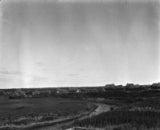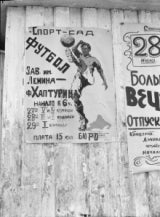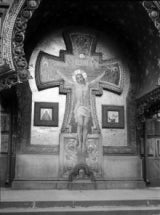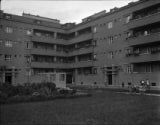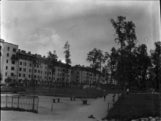Dana Porter Library, first floor
University of Waterloo Library
Waterloo, Ontario N2L 3G1
519-888-4567 x42619 or x42445
First Five Year Plan, 1928-1932
By the time Spencer set foot in the Soviet Union in the summer of 1931, Stalin's first five-year plan was almost three years under way. Following a troubling era of war and famine after the Russian Revolution, the first five-year plan was introduced for the rapid and wide-scale industrialization of the Soviet Union. Modern machinery and tractors were adopted en masse to maximize production efficiency, and thousands of foreign engineers like Harry Byers were hired on contract to teach Soviets the operation and maintenance of machinery.
Alongside collectivization, quotas were imposed on village crop production, requiring a certain amount over to the state. However, the amounts required were often so high that virtually all output would be seized, leaving farmers nothing to sell or eat. While some farmers ironically died of starvation, others were executed or imprisoned for ignoring imposed quotas. During Spencer's 1931 visit, food shortages were still largely contained in the countryside. By 1932 however, the famine became increasingly dire and widespread, and millions ultimately perished from starvation by 1933.
Other Soviet Policies
Education and Propaganda
Religion
Between 1921 and 1928, the Soviet Union began a series of anti-religious campaigns. Through propaganda, the clergy were portrayed as lecherous and greedy, while believers were depicted as backward and ignorant. Although religion was not illegal in itself, many religious leaders were arrested on false charges and executed. Places of worship were also shut down one by one, as they could not pay the exorbitant taxes levied upon them. By the time Spencer visited the Soviet Union in 1931, religious persecution had come to a temporary halt, and so the only religious suppression Spencer witnessed was through education and propaganda. By the mid 1930's, anti-religious campaigns would again pick up, with increased severity and force.
Gender
Following the Russian Revolution, gender equality became an official mandate in the new Soviet state. Emancipated from domestic chores and child rearing, women were expected to work alongside men. On policy grounds, laws were enacted to grant women's suffrage, increase their wages, and legally require maternity leave. Daycares were also established so that children could be cared for while women worked. Divorce became easily accessible, and adultery was no longer illegal. In spite of these legal changes however, the social attitude toward women remained very much the same, particularly in their role as caregivers and domestic keepers. Sexist attitudes and double standards in behviour continued to exist, while women's wages never quite equalized with men's in spite of legal equality.
Communes and Collectives
Communes were highly encouraged by the Soviet government, as the population shift from countryside to city created a severe housing shortage. In most cases, communes were apartments where residents only lived together and shared facilities, while in other instances residents both worked and lived together, and shared wages. Spencer visited one such factory commune. Although communal living was intended to improve work habits, order, and brotherhood, its more extreme forms seldom lasted for more than several years. The communal apartment however, survived as a matter of architectural necessity in midst of housing shortages.
Camps and Criminals
Under Stalin, the first forced labour camps were created in 1918 across isolated locations in the Soviet Union. They are referred to as "Gulag", from the camp administration agency's name. Anti-revolutionaries, political enemies, religious leaders, suspected spies, criminals, and virtually any person deemed potentially disruptive, were targeted. When Spencer visited the Soviet Union in 1931, Stalin's reign had only just begun. Ultimately, tens of millions of people would perish in the camps from long hours of labour in conjunction with inadequate food, clothing, healthcare, shelter, and sleep. Unbeknownst to Spencer, the clean, idyllic corrective labour camp he had been shown—heralded as typical of all Soviet camps—was in fact the only one of its kind, constructed purely for the viewing of foreigners.
Ragsdale, Hugh. The Russian Tragedy: The Burden of History. Armonk, NY: M.E. Sharpe,
1996.
Stites, Richard. Revolutionary Dreams: Utopian Vision and Experimental Life in the Russian
Revolution. New York: Oxford UP, 1989.
